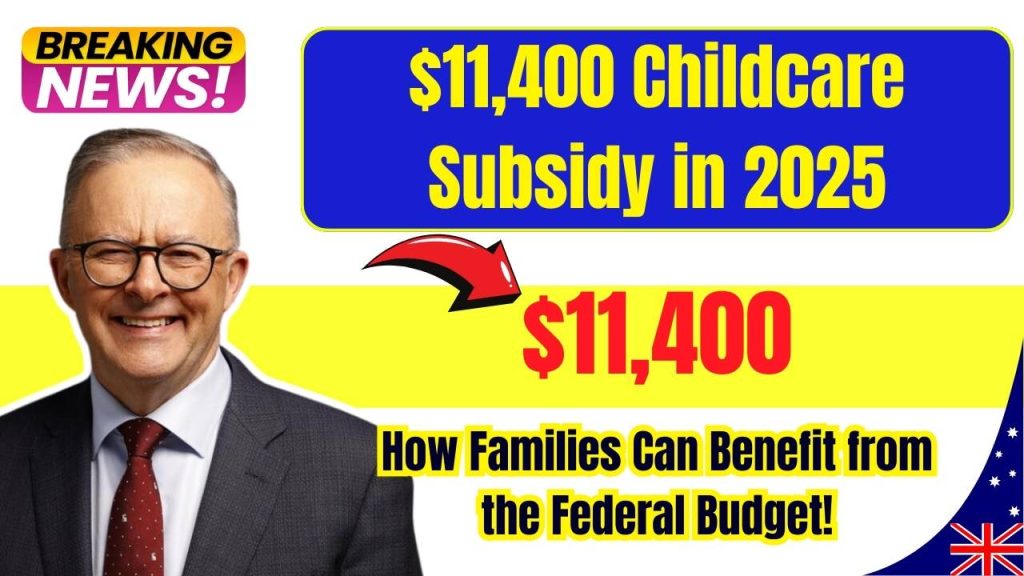$11,400 Childcare Subsidy in 2025: Australia’s 2025 Federal Budget has delivered some exciting and transformative news for families across the country. If you’re a parent balancing the demands of work, study, or simply managing the daily care of young children, the introduction of the new $11,400 childcare subsidy could have a truly meaningful impact on your household. This reform isn’t just about putting money back in your pocket – it’s about reshaping access to early childhood education to make it more inclusive, equitable, and supportive of all families, regardless of their circumstances.

With the cost of living continuing to be a key concern for many Australians, these changes come at a critical time. In this article, we take a deep dive into what the 2025 childcare subsidy reforms mean for you: how the program works, who stands to benefit, how much money families can save, and how this landmark policy fits into the broader vision for early childhood education in Australia.
$11,400 Childcare Subsidy in 2025
| Feature | Details |
|---|---|
| Subsidy Amount | Up to $11,400 per year in savings per child |
| Start Date | January 1, 2026 |
| Eligibility | All families earning up to $533,280/year; no activity test required |
| Childcare Covered | 3 days (72 hours) of subsidised care per fortnight for all families |
| Income Cap | $533,280 annual family income |
| Extra Support | $5 billion in funding for childcare infrastructure and worker wages |
| Official Source | budget.gov.au |
The introduction of the $11,400 Childcare Subsidy in 2025 reflects a major step forward in Australia’s approach to supporting families and strengthening early childhood education. By eliminating barriers like the activity test and introducing the Three-Day Guarantee, the government is making childcare more accessible, more affordable, and more equitable for everyone.
Whether you’re a parent hoping to return to the workforce, someone managing part-time work and parenting, or a stay-at-home carer needing time for self-care or study, this reform offers meaningful relief and flexibility.
The childcare reforms are more than just a budget measure – they’re an investment in the future of Australia, its children, and its workforce.
Understanding the 2025 Childcare Subsidy Reforms
The childcare subsidy has long been a critical support mechanism for working families, helping parents afford the high costs associated with quality childcare services. However, the previous system had a significant barrier: the “activity test.” Under that rule, families had to demonstrate they were working, studying, or volunteering a certain number of hours each week to qualify for subsidised care. While this worked for many, it left others – especially those between jobs, facing illness, caring for other family members, or dealing with life transitions – struggling to access the care their children needed.
The 2025 childcare reform makes a bold change. From January 1, 2026, every family in Australia earning less than $533,280 per year will qualify for three days (72 hours) of subsidised childcare every two weeks, regardless of whether they meet an activity requirement. This is being introduced as the Three-Day Guarantee, and it’s expected to be a game-changer.
Why It Matters
The implications of this change are vast and deeply positive. Removing the activity test opens the door to early education for thousands of children who were previously excluded due to their parents’ employment or personal circumstances. It will support:
- Wider access to early childhood education, promoting better development outcomes for children from all backgrounds
- Reduced financial pressure on families trying to juggle tight budgets
- Greater flexibility for parents who are re-entering the workforce, upskilling, or managing complex care responsibilities at home
- Improved mental health and wellbeing for parents who need respite or structured time during the week
Research has consistently shown that access to high-quality early education improves children’s social, emotional, and cognitive development. By ensuring all families can access at least three days of care per fortnight, this policy aims to give every child a stronger start in life.
How Much Can Families Save?
One of the most compelling aspects of this reform is the potential for significant cost savings for families. According to the Federal Government’s projections on budget.gov.au, here’s how the subsidy will impact typical households:
- A family earning $90,000 annually, using childcare three days per week, could save approximately $230 per week, translating to around $11,400 in annual savings.
- A family with an income of $140,000 per year may save approximately $10,110 annually, depending on the childcare provider and hours used.
These numbers are based on average daily childcare rates and assume full usage of the Three-Day Guarantee. While actual savings will vary based on location, provider rates, and the number of children in care, the bottom line is clear: this policy will reduce out-of-pocket childcare costs for most families.
Real-World Example:
Consider a parent living in Melbourne with a toddler attending a long day care center three times a week. The average daily rate is about $120, which adds up to $360 per week – or over $18,700 a year. With the new subsidy kicking in, this family could see their annual childcare costs drop by more than half, depending on their income tier. That’s money that could go toward groceries, rent, savings, or even enrolling the child in enrichment programs or extracurricular activities.
Who Is Eligible for the New Subsidy?
The updated scheme is designed with broad inclusivity in mind, covering a wide range of family types, income levels, and personal situations. Here are the key eligibility criteria:
Income Threshold
- Families with a combined annual income of up to $533,280 are eligible for the Three-Day Guarantee.
No Activity Test
- The removal of the activity test means there are no work, study, or volunteer requirements to receive the subsidy. This supports families facing unique challenges or transitions.
Age of Children and Approved Care Types
- The subsidy applies to children below school age who are enrolled in approved childcare services, such as:
- Long day care
- Family day care
- Occasional care
- In-home care (in specific circumstances)
If you’re unsure whether your childcare provider qualifies, you can check the official Services Australia childcare page.
What Is the Three-Day Guarantee?
The Three-Day Guarantee is a new national standard that ensures families can access 72 hours of subsidised childcare per fortnight, no matter their employment status. The goal is to give children a consistent early learning experience, while offering parents a stable window of time to work, rest, or pursue other commitments.
This guarantee is intended to:
- Level the playing field for children from all socio-economic backgrounds
- Enable parents to take on flexible, part-time, or casual employment
- Give caregivers the breathing room to focus on their health, education, or caregiving for others
The reform recognises that families don’t fit into a one-size-fits-all mold. Some parents work non-traditional hours, others are sole caregivers or living in remote areas. The Three-Day Guarantee gives families the autonomy to make decisions that are best for them.
Broader Investments in Early Childhood Education
Beyond individual family savings, the Federal Government has committed $5 billion toward creating a world-class early childhood education system that benefits children, parents, and educators alike.
$1 Billion – Building Early Education Fund
- Will fund the construction of 160 new childcare centres in regions with unmet demand, particularly outer suburban and regional areas where childcare is scarce or oversubscribed.
$3.6 Billion – Boosting Educator Pay
- The Worker Retention Payment will enhance wages for up to 200,000 early educators and teachers, addressing the critical issue of workforce shortages and improving quality of care across the board.
These investments will help reduce waitlists, increase availability of spots in high-demand regions, and improve job satisfaction and retention among the dedicated professionals who care for our youngest citizens.
Practical Tips for Families
If you’re a parent, carer, or guardian wondering how to prepare for these changes, here are some actionable steps you can take:
1. Check Your Eligibility Now
Go to the Services Australia childcare subsidy page and use their eligibility checker. This will help you plan ahead and understand your entitlements.
2. Talk to Your Childcare Provider
Ask how they will apply the Three-Day Guarantee. Many centers are already preparing for the shift and may be able to offer advice on how your fees will be impacted.
3. Start Planning for 2026
The new policy starts January 1, 2026. Begin researching childcare options, especially if you live in a high-demand area. Getting on waitlists early is always a smart move.
4. Monitor Government Updates
Subscribe to newsletters or check updates from budget.gov.au and education.gov.au to stay informed about policy changes, additional funding announcements, or pilot programs.
5. Factor It into Your Family Budget
Use the projected savings to adjust your household budget. The reduction in childcare expenses might free up funds for savings, health insurance, or extracurricular activities for your child.
Parents in Australia to Get $533290 in Child Care Aid – Check Payment Details!
New Centrelink Rates for April 2025 Are In; Here’s What You Need to Know
Up To $11,000–$13,000 in Baby Bonus Payments – Are You Eligible to Get it?
FAQs About $11,400 Childcare Subsidy in 2025
Q1: Does the subsidy apply to all families?
Yes. If your combined family income is below $533,280 per year, you are eligible. There is no activity test requirement.
Q2: Can stay-at-home parents still access subsidised care?
Absolutely! The removal of the activity test is one of the biggest wins of the reform. Stay-at-home parents can now access three days of care per fortnight, creating opportunities for rest, study, or other responsibilities.
Q3: Do current subsidy recipients need to reapply?
No. Existing families receiving the childcare subsidy will have their entitlements updated automatically in coordination with Services Australia and their childcare provider.
Q4: When will the policy changes take effect?
The subsidy reform and Three-Day Guarantee officially start on January 1, 2026.
Q5: What types of childcare are eligible?
The reform applies to approved childcare services, including long day care, family day care, and other early learning centers. Always confirm with your provider.
Q6: What if I need more than 3 days per fortnight?
You may still qualify for additional subsidised care based on your family’s activity level or income. Check with Services Australia for a full assessment of your entitlement.











